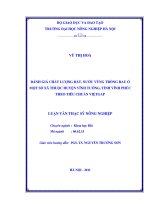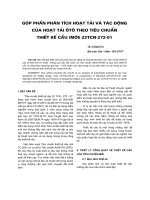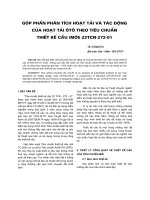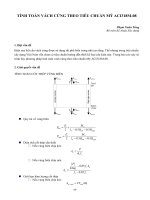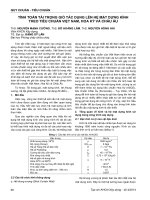TÍNH TẢI GIÓ THEO TIÊU CHUẨN- ASCE7
Bạn đang xem bản rút gọn của tài liệu. Xem và tải ngay bản đầy đủ của tài liệu tại đây (802 KB, 40 trang )
Wind Loads:
The ASCE 7 Provisions
CE 694R – Fall 2007
T. Bart Quimby, P.E., Ph.D.
Quimby & Associates
A Beginner's Guide to ASCE 7-05
Permitted Design Methods
Method 1—Simplified Procedure
(ASCE 7-05 Section 6.4)
Low rise buildings. This is an outgrowth of work done
for/by the metal building industry.
Method 2—Analytical Procedure
(ASCE 7-05 Section 6.5)
The typically used procedure. This is the main focus of
this presentation.
Method 3—Wind Tunnel Procedure
(ASCE 7-05 6.6)
See ASCE 7-05 6.1.2
A Beginner's Guide to ASCE 7-05
Important Definitions
Basic Wind Speed
Building open, enclosed, partially enclosed
Low-Rise Building
See ASCE 7-05 6.2
A Beginner's Guide to ASCE 7-05
Exposure Categories
Exposure A – Deleted in ASCE 7-02 and later
Extremely sheltered. Large city centers with tall buildings.
Exposure B
Urban and suburban areas, wooded areas, areas with many
closely spaced obstructions.
Exposure C
Open terrain with scatter obstructions. Airports, areas that
are generally flat open country.
Exposure D
Flat, unobstructed areas and water surfaces outside
hurricane prone regions. This category includes smooth mud
flats, salt flats, and unbroken ice that extend 5,000 ft or 20
times the building height in the upwind direction.
See ASCE 7-05 6.5.6 & C6.5.6 (See images!)
A Beginner's Guide to ASCE 7-05
Determining Exposure
Wind Direction & Sectors (ASCE 7-05
6.5.6.1)
the exposure of the building or structure shall
be determined for the two upwind sectors
extending 45
o
either side of the selected wind
direction.
the exposure resulting in the highest wind
loads shall be used to represent the winds
from that direction.
A Beginner's Guide to ASCE 7-05
ASCE 7-05 Wind Pressures
The basic form of the pressure equation:
p = qGC
Where
p = a wind pressure on a surface
q = velocity pressure. This is the pressure due to a moving
fluid on a flat plate
G = gust factor. The gust factor accounts for dynamic
interaction between the flowing air and the structure
C = pressure coefficient. The pressure coefficient accounts
for varying pressure across a surface.
A Beginner's Guide to ASCE 7-05
Velocity Pressure, q
q
z
=Velocity Pressure = 0.00256K
z
K
zt
K
d
V
2
I (lb/ft
2
)
Constant 0.00256
V = Basic wind speed in mph
I = Importance Factor (i.e. different MRI)
K
z
= Exposure Coefficient
K
zt
= Topographical Factor
K
d
= Wind Directionality Factor
Evaluated at an elevation z:
q
z
= 0.00256V
2
IK
z
K
zt
K
d
Evaluated at the building mean roof elevation, h:
q
h
= 0.00256V
2
I K
h
K
ht
K
d
See ASCE 7-05 6.5.10
A Beginner's Guide to ASCE 7-05
The Velocity Coefficient
Based on the average density of air at sea level.
P'
1
2
DV
2
'
1
2
[
0.0765
32.2
][
5280
3600
]
2
V
2
'0.00256V
2
See ASCE 7-05 C6.5.10
A Beginner's Guide to ASCE 7-05
Basic Wind Speed, V
Obtained from Wind Speed maps in ASCE 7-
05 Figure 6-1.
Determined by localized research using
approved probabilistic methods.
“The basic wind speed shall be increased
where records or experience indicate that the
wind speeds are higher than those reflected
in Fig. 6-1.” (ASCE 7-05 6.5.4.1)
See ASCE 7-05 6.5.4
A Beginner's Guide to ASCE 7-05
The Importance Factor, I
Category I: I = .87
MRI is 25 years
Category II: I = 1.00
MRI is 50 years
Category III & IV: I = 1.15
MRI is 100 years
Building Categories are listed in ASCE 7-05
Table 1-1.
See ASCE 7-05 6.5.5, Table 6-1 and Commentary 6.5.5
A Beginner's Guide to ASCE 7-05
Velocity Pressure Exposure
Coefficients, K
z
and K
h
Modifies basic wind pressure for heights
other than 33 ft and exposures other than
exposure C.
Can compute K directly from equations in the
commentary for any height and/or exposure.
Good for spreadsheet or computer
programming.
For elevations less than 15 ft, use K
15
.
For elevations above gradient height use K
g
.
See ASCE 7-05 6.5.6.6, Tables 6-2 and 6-3, and C6.5.6.6
A Beginner's Guide to ASCE 7-05
K
z
& K
h
Computation
K
z
= 2.01(z/z
g
)
2/a
K Computation
0.00
0.50
1.00
1.50
2.00
2.50
0 500 1000 1500 2000
Elevation, z (ft)
K
Exposure B
Exposure C
Exposure D
When z > z
g
use z = z
g
When z < 15 use z = 15 ft
A Beginner's Guide to ASCE 7-05
Topographical Factor, K
zt
K
zt
= 1.0 when:
H/L
h
< 0.2, or
H < 15' for Exposures C & D,
or
H < 60' for Exposure B.
K
zt
= (1+K
1
K
2
K
3
)
2
See ASCE 7-05 6.5.7 & Commentary 6.5.7
A Beginner's Guide to ASCE 7-05
K
zt
Constants
A Beginner's Guide to ASCE 7-05
K
zt
Multipliers by Equation
See ASCE 7-05 Figure 6.4
A Beginner's Guide to ASCE 7-05
Directionality Factor, K
d
This factor shall only be
applied when used in
conjunction with load
combinations specified
in Sections 2.3 and 2.4.
The wind load factors
changed when the
directionality factor was
extracted.
See ASCE 7-05 6.5.4.4 and
Table 6-4
A Beginner's Guide to ASCE 7-05
The Gust Factor, G
Factor accounting for:
Gustiness and turbulence
Gust frequency
Gust size
Integral scale longitudinal and lateral
Frequency of structure
Structural damping
Aerodynamic admittance
Gust correlation
A Beginner's Guide to ASCE 7-05
Gust Factor, G
For stiff buildings and stiff structures
G = 0.85
For flexible buildings and other structures
Calculate “by a rational analysis that
incorporates the dynamic properties of the
main wind-force resisting system.”
A Beginner's Guide to ASCE 7-05
See ASCE 7-05 6.5.8
Pressure Coefficients, C
The pressure coefficients are based on
The enclosure category of the structure
The location on a structure for which a pressure is to
be computed.
The pressure coefficients have been determined
experimentally from wind tunnel studies done on
regular shaped structures
The coefficient represents the ratio between measured
pressure and the computed basic velocity pressure.
C'
P
measured
1
2
DV
2
A Beginner's Guide to ASCE 7-05
Enclosure Classifications
A building is to be classified as one of the following:
Open
A
o
> 0.8A
g
for each wall
Partially Enclosed
A
o
> 1.10 A
oi
, and
A
o
> min[4 sqft , 0.01A
g
], and
A
oi
/A
gi
< 0.20
Enclosed
A building that is neither open nor partially enclosed.
A Beginner's Guide to ASCE 7-05
See ASCE 7-05 6.2 & 6.5.9
Location of Pressure
ASCE 7 provides means for computing forces on
various surfaces.
The building envelope surfaces experience pressure
on both sides (i.e. external and internal).
A Beginner's Guide to ASCE 7-05
Internal Pressure Coefficients, GC
pi
Internal pressure is fairly easy because the air is
relatively stagnant and the shape of the structure
does not affect it’s magnitude.
As gusting is not a concern internally, the gust factor
and the pressure coefficient are combined.
GC
pi
The magnitude of the internal pressure coefficient is
strictly dependent on the enclosure classification.
The pressure can be both positive or negative (i.e.
suction) depending on the direction of the wind
relative to opening for partially enclosed or enclosed
buildings.
Both internal pressures must be considered.
See ASCE 7-05 6.5.11.1 & Figure 6-5
A Beginner's Guide to ASCE 7-05
Internal Pressure
A Beginner's Guide to ASCE 7-05
External Pressure Coefficients, C
p
As external surfaces are subject to “flowing” air, the
pressure varies considerably on the building surface
depending on structural configuration and direction of
the wind.
Coefficients also depend on whether the resulting
forces are to be used to design/analyze:
Main Wind-Force Resisting Systems
Structural elements that support large areas exposed
to the wind
Components & Cladding
Structural elements that support small areas exposed
to the wind
See ASCE 7-05 6.5.11.2 & Figures 6-6, 6-7, and 6-8
A Beginner's Guide to ASCE 7-05
Buildings with Roofs Consisting of
Flat Surfaces
ASCE 7-05 Figure 6-6 gives the external
coefficients of wall and roof surfaces.
See ASCE 7-05 Figure 6-6
A Beginner's Guide to ASCE 7-05
